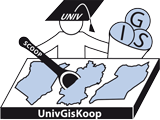Aim
The Project Aim is not to set-up new study programs, but to streamline up-to-date GIS teaching into existing curricula structures across various departments by integrating geodata use applications of regional relevance into selected undergraduate and graduate courses. This includes the development and implementation of adequate modules supporting a wide-spread application of GIS in the study fields offered. The partnership aims at capability enhancement for two universities in developing countries by strengthening or establishing centres of competence in GIS. Benefits result not only from demonstration of geomatics technology and knowledge transfer from Germany to Kenya and Uganda but are also closely linked to the harmonization of the GIS teaching as a step towards easing student mobility between East African institutions of high education. Furthermore, geomatics facilities are considered here as an empowerment tool for sustainable development.
Background
In order to apply and use geo-spatial data to its full potential their competent understanding and handling is required. Geomatics - the discipline of gathering, storing, processing, analyzing, and delivering spatially referenced information - is gaining increasing attention due to the tools it offers which can be of inter- and transdisciplinary use in a wide array of applications such as resource management, local governance, environment as well as urban and integrated regional planning. Geographic information systems (GIS) in particular are now becoming, although slowly, indispensable in local government units (LGUs) and the industry also in Kenya and Uganda. Maps are and have ever been highly elaborated means for communicating complex interrelationships of our highly complex world. But GIS offers much more than just visualization or map making; it is equipped with a myriad of specific functionality to perform simple or complex analyses, too, for producing new information.
Universities are one of the most fertile beds where new theories and techniques can germinate into practical applications. Therefore it is rather unfortunate that the academic sector in East Africa has been slow to make use of the full potentials that competent analysis of geodata offers as well as to pick-up on the GIS technology and their deployment in the various courses offered. Besides a lack of financial sources, the main reason might be a shortage in map reading literacy as compared to the western world countries. Another major drawback always cited in case of failure in establishing GIS is the lack of institutional support. This lacking support may be the pitfall for continuity and updating of GIS-related university modules and for keeping GIS labs running at universities of developing countries.
The three universities use geodata and GIS to very different extents regarding both education and research. At the German university, training geomatics either in the realm of cartography, surveying, or geo-information management, geodata use and GIS are fully established as integral part already at the Bachelor level where normally three modules focus on GIS alone. At the Kenyan and Ugandan universities capacities are available, although rather limited in regard to equipment, and underused in regard to courses at both undergraduate and graduate level. GIS is often taught decoupled and not related or integrated into specific fields for which the consideration of the geospatial dimension is playing an ever increasing role. This partnership will, therefore, strengthen and standardise GIS training in the two East African universities, and enhance staff development and research work in geomatics.
Within the BMBF-funded interdisciplinary research project BIOTA East Africa (2001-2010) HsKA was responsible for geodata processing for the Kakamega-Nandi forest area (Kenya) as well as for the areas of Budongo and Mabira Forests (Uganda) supporting inter- and transdisciplinary research on sustainable use and conservation of biodiversity. At the end of the project all spatially presentable results were combined in one representative volume– ‘The BIOTA East Africa Atlas. Rainforest Change over Time’.The printed atlas as well as the vast amount of digital geodata(i.e. more than 500 geodatasets) hold an enormous potential to be used for training students in map reading skills, handling of geospatial data as well as in recognizing the value of geoinformation that helps to reveal spatial patterns or correlations. With a focus on forest change the available geospatial data provide not only a solid ground for global change-related studies but it is of high regional relevance. As such it offers the chance of a regional approach in teaching by including localized aspects of an African orientation.






